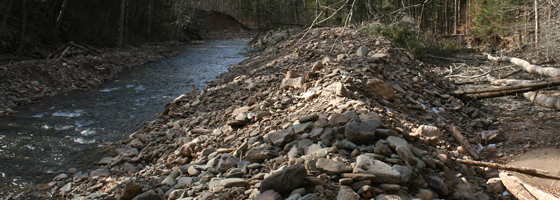Study to track ecological effects of Pennsylvania creek dredging

Tropical Storm Lee brought massive flooding to Pennsylvania in 2011. The storm also kindled a resurgence of a long-standing flood control tactic in the region: channelizing creeks with heavy equipment, scraping stream beds clean of cobble, tree trunks and anything else that might slow down rising water.
The idea behind the excavation is that straightening and smoothing the streams will keep flood water moving downstream quickly without spreading out into the floodplain and threatening the homes and other structures people have built there.
While the process might help ease the minds of floodplain dwellers, it’s likely less beneficial for some of the region’s other residents.
“These are nice little trout streams,” said Steven Rier, an associate professor of biology at Bloomsburg University in Pennsylvania. “These are not little agricultural ditches in the Midwest. These are actually nice little mountain streams that are full of brook trout.”
Though it seems clear that scouring classic fish habitat from a stream will be bad for fish, the potential for more channelization leaves Rier with questions about the potential impact on the wider functioning of stream systems.
“What does that do in terms of ecosystem services and the overall health of the stream?” Rier said. “What does it do to the ability of a stream to process nutrients? What does it do to the ability of a stream to store organic matter, and ultimately translate that into fish production?”
To find some answers, Rier and colleagues are studying creeks in north-central Pennsylvania with recently channelized stretches. They’ll compare measurements in the altered sections with nearby segments that have been left alone. The goal is to express the effects of channelization in terms of stream metabolism, and ultimately economic value.
One method to assess metabolism is comparing 24 hours worth of dissolved oxygen measurements at two locations on a stream. The fluctuation in oxygen levels over that span can give researchers an idea of the daily proceedings of the stream’s plant, animal and microbe communities.
“It’s a way of getting at the amount of oxygen that’s being released due to photosynthesis and the amount of oxygen that’s being taken up due to respiration,” Rier said.
Rier is measuring oxygen with a series of YSI ProODO Optical Dissolved Oxygen Meters. By adjusting for the time it takes for water to flow from one meter to get to the next, researchers can track oxygen fluctuations in one parcel of water as it moves downstream. Measurements also have to be adjusted to account for other sources of oxygen variation, like atmospheric exchange.
The project will also assess how well the study streams process nutrients. The streams don’t carry much phosphorous, but receive some nitrogen through atmospheric deposition.
“The healthy streams are taking up a good part of this nitrogen before it ends up going downstream to the rivers and ultimately, in our case, Chesapeake Bay,” Rier said. “Which obviously has some real nutrient issues.”
Channelization could cut nutrient uptake by smoothing out the twists, turns and structures where leaf litter and other natural debris collect. Those organic matter deposits are base of operations for the microbes that take up nutrients.
Though stream metabolism is an important scientific indicator of overall stream health and function, Rier eventually hopes to express the cost of dramatically reshaping streams in more widely understood terms: dollars and cents.
“How much value do you lose if you decrease the fishery of a particular stream?” he asked. “How much value do you lose if you decrease the retention of nitrogen, which ultimately has an impact on Chesapeake Bay?”
Photo: North Branch of Fishing Creek channelized for flood control after Tropical Storm Lee. Photo: Steven Rier.





0 comments